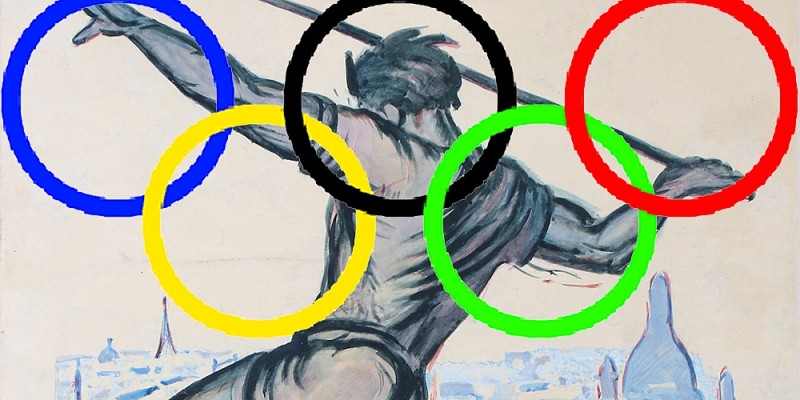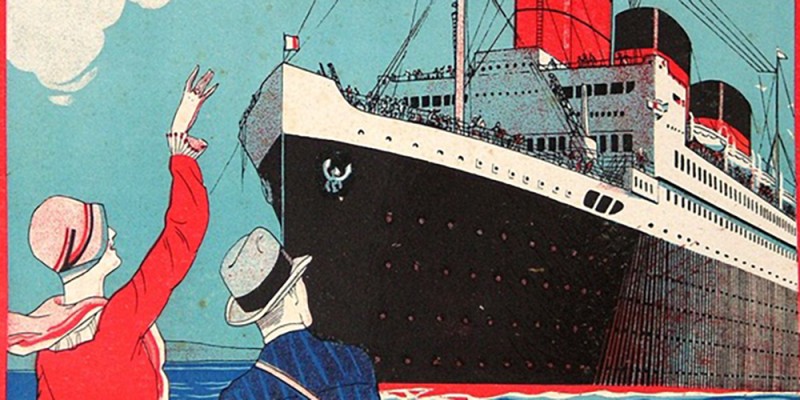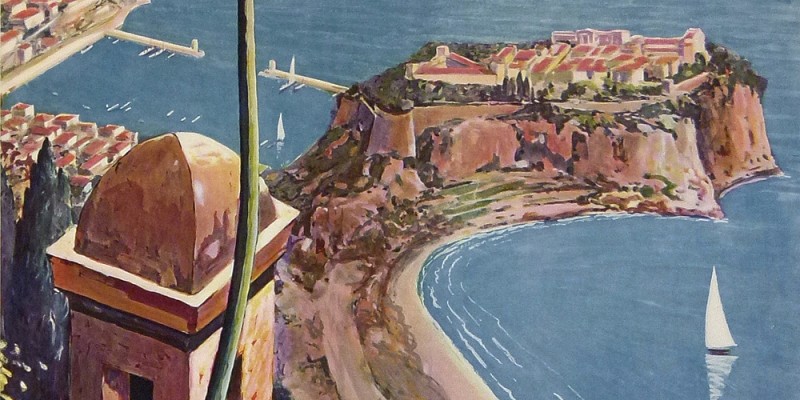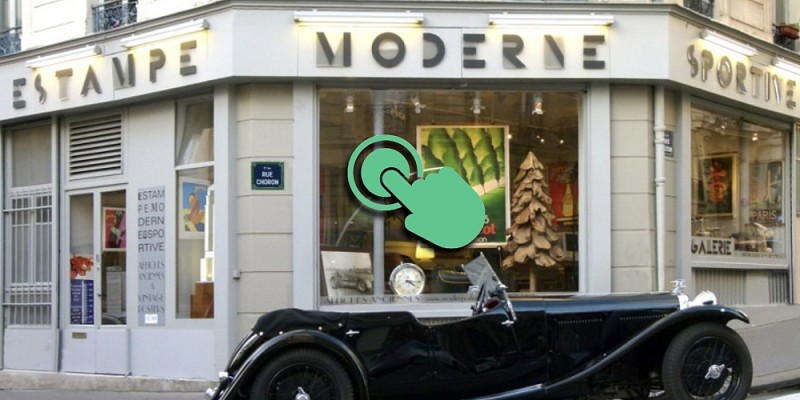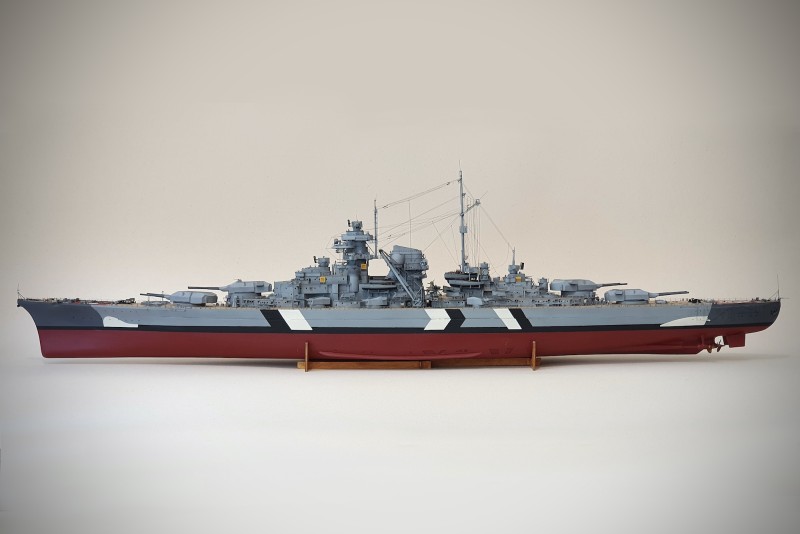
















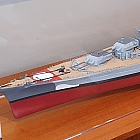

BISMARCK GRANDE MAQUETTE D'EXCEPTION DU CELÈBRE CUIRASSÉ ALLEMAND EN BOIS ET MÉTAL.
Reduct models from .
LARGE EXCEPTIONAL, ULTRA DETAILED MODEL OF THE FAMOUS GERMAN BISMARCK BATTLESHIP IN WOOD AND METAL.
THIS MODEL IS PROTECTED BY A PLEXIGLASS DISPLAY BASE
SHOWCASE DIMENSION L.1400 x H.450 x l.250 mm Thickness 10mm
Historical
The Bismarck was the first Bismarck-class battleship built for the Kriegsmarine under Nazi Germany. Named after German Chancellor Otto von Bismarck, who was one of the architects of German unification in the 19th century, she was, along with her sister ship the Tirpitz, the largest warship used by Germany.
Build and Features
The Bismarck was ordered as the Ersatz Hannover to replace the old pre-dreadnought SMS Hannover launched in 1905. The contract for her construction was awarded to the Blohm & Voss shipyard in Hamburg where the keel was laid on 1 July 1936. The The ship was launched on February 14, 1939 in the presence of Adolf Hitler and was christened by Dorothee von Löwenfeld, the granddaughter of former Chancellor Otto von Bismarck who had given her name to the battleship4. It was completed in the summer of 1940 and entered service on August 24, 1940.
The Bismarck had an overall length of 251 meters, a waterline length of 241.6 meters, a beam of 36 meters and a loaded draft of 9.9 meters. With her sister ship the Tirpitz, she was the largest ship built by Germany (but not in the world: in the very first row were the 'Yamato' (1937) and the 'Musashi' (1938), Japanese battleships) . Her fully loaded displacement of 50,300 tons surpassed that of all other European battleships. Only the HMS Vanguard, put into service after the Second World War, will exceed it.
The Bismarck was propelled by three propellers driven by three Brown-Boveri steam turbines (Blohm & Voss) powered by twelve Wagner oil-fired boilers developing an output of 111.98 MW and which provided the vessel with a maximum speed of 29 knots (53. 7 km/h). During the tests, the maximum speed reached was, according to the sources, 30.01 knots (55.6 km/h) or 31.1 knots (57.6 km/h).
The main armament consisted of eight 380 mm guns arranged in four twin turrets, two forward (“Anton” and “Bruno”) and two aft (“Caesar” and “Dora”). Each of these turrets could fire an 800 kilogram shell 36,520 meters at an optimal rate of three per minute. The secondary artillery comprised twelve 150 mm guns as well as sixteen, sixteen and twelve 105 mm, 37 mm and 20 mm anti-aircraft guns respectively. The armored belt had a thickness of 320 mm and it was surmounted by bridges from 50 to 120 mm. The main turrets were protected by 360 mm of armor in front, 220 mm on the sides and 130 mm on top.
The normal crew consisted of 103 officers and 1,962 sailors but it could exceed 2,200 including the prize crew, the staff of the fleet and the war correspondents. The Bismarck also carried four Arado Ar 196 seaplanes.
Operational career
On September 15, 1940, three weeks after commissioning, the Bismarck left Hamburg for sea trials in Kiel Bay. The minesweeper Sperrbrecher 13 then escorted her to Cape Arcona and then to Gotenhafen for trials in the Gulf of Danzig. During testing, the ship's ability to turn using only her propellers proved poor, and the crew noted that even running the outer propellers at full speed and in opposite directions only changed the battleship's heading slightly. Conversely, the speed tests demonstrated the proper functioning of the machines while the artillery tests at the end of November were very satisfactory. The Bismarck remained at sea until her return to Hamburg on December 9, where she underwent some minor modifications.
The ship was scheduled to go to Kiel on January 24, 1941, but the sinking of a merchant ship in the Kiel Canal blocked its use. Bad weather prevented the removal of the wreck, and the Bismarck did not sail up the channel until March. This delay angered Lindemann who remarked that "Bismarck has been tied up in Hamburg for five weeks...the loss of valuable time at sea which has resulted cannot be compensated and a significant delay in the final deployment of the ship is therefore unavoidable" . While in Hamburg, the battleship was visited by Captain Anders Forshell, the Swedish military attache in Germany, who wrote a detailed description of the ship on his return to Sweden. The document was secretly transmitted to the United Kingdom by pro-British elements of the Swedish Navy, which enabled the Royal Navy to obtain its first information on the ship even if important elements such as the radius of action, the speed peak and displacement remained unknown.
On March 6, the Bismarck
finally sailed for Kiel with an escort of Messerschmitt Bf 109 fighters, two auxiliary cruisers and an icebreaker. On the morning of March 8, she ran aground for an hour on the south bank of the canal. Arriving in port the next day, her crew took on ammunition, supplies and fuel and painted Dazzle designs on the hull. British bombers unsuccessfully attacked the port on March 12. On March 17, the old battleship Schlesien, used as an icebreaker, escorted the Bismarck to Gotenhafen for further trials.
The Oberkommando der Marine (“Fleet High Command”; OKM) commanded by Admiral Erich Raeder, intended to continue its operations of attacking Allied convoys using its surface ships. The two Scharnhorst-class battleships were then in the French port of Brest, which they had joined at the end of Operation Berlin during which they had sunk 22 Allied ships. The Bismarck's sister ship, the Tirpitz, being almost complete, it was envisaged that the four battleships would end up in the Atlantic and the date was set for April 25, 1941 during the new moon to prevent the British from spotting them.
This plan proved unrealizable as the work to complete the Tirpitz took longer than expected and she was not ready for combat until the end of 1941. At the same time, the Gneisenau was torpedoed in the port of Brest on 6 April and then shelled three days later while undergoing repairs in drydock. The damage was limited but the ship remained unavailable for several months while Scharnhorst's boilers had to be replaced; the two battleships of the Scharnhorst class were therefore not available for the planned operation. To make matters worse, the British bombardment of the Kiel arsenals slowed down repairs on the heavy cruisers Admiral Scheer and Admiral Hipper, which would not be available until mid-summer. Faced with these difficulties, Admiral Günther Lütjens, chosen to lead the sortie, suggested postponing it until the Scharnhorst or the Tirpitz could participate, but the OKM decided to launch Operation Rheinübung with only two ships: the Bismarck and the heavy cruiser Prinz Eugen. In a meeting with Admiral Raeder in Paris on April 26, Lütjens finally decided to launch the operation as quickly as possible so as not to give the enemy any respite.
Operation Rheinübung
On May 5, Adolf Hitler and Wilhelm Keitel visited the Bismarck in Gotenhafen and the German Chancellor discussed with Lütjens the upcoming mission. On May 16, the latter reported that his two ships were ready for Operation Rheinübung and he was cleared to put to sea on the evening of May 19. As part of the operation, a dozen tankers were deployed in the Atlantic to refuel the Bismarck and the Prinz Eugen while four submarines were positioned between Nova Scotia and the British Isles to spot Allied convoys.
At the start of her mission, the Bismarck had 2,221 officers and sailors, including a prize crew of 80 men who could be used to maneuver the ships captured during the operation. The battleship departed Gotenhafen on 19 May at 2:00 a.m. heading for the Danish Straits; it was joined at 11:25 a.m. by the Prinz Eugen which had left Cape Arcona the day before. The two ships were escorted by three destroyers—Z10, Z16, and Z23—as well as several minesweepers, while the Luftwaffe provided air protection. Around noon on May 20, Lindemann informed the crews of their mission.
Around the time of the commander's communication, a dozen Swedish reconnaissance aircraft spotted the ships and reported their course without being spotted by the Germans. An hour later, the flotilla passed the Swedish cruiser HMS Gotland and the latter followed it discreetly for two hours in the Kattegat. He then informed the Swedish General Staff that "two large ships, three destroyers, five escort ships and 10-12 aircraft passed Marstrand". Lütjens and Lindemann believed that the secret of the operation had been exposed and indeed, the Swedish report was transmitted to the British military attache who in turn informed the Admiralty. Code breakers at Bletchley Park confirmed that an Atlantic raid was imminent as they had deciphered German reports that the Bismarck and Prinz Eugen were embarking prize crews and had requested additional sea charts. Two Supermarine Spitfire fighters were dispatched along the Norwegian coast to spot the German flotilla.
At the same time, German reconnaissance flights noted that one aircraft carrier, three battleships and four cruisers remained at anchor at the main British naval base at Scapa Flow in Scotland; this caused Lütjens to consider that the British were ultimately unaware of his release. On the evening of 20 May, the Bismarck and the rest of the flotilla reached the Norwegian coast and the minesweepers were sent back to Germany. The following day, radio operators from Prinz Eugen picked up British radio messages requesting reconnaissance flights to locate two battleships and three cruisers heading up the Norwegian coast. At 7:00 a.m., the German sailors spotted four unidentified aircraft, which quickly sailed away. In the early afternoon, the flotilla arrived in Bergen and anchored in the Grimstadfjord.
While the Bismarck was in Norway, two Bf 109 fighters were flying around the fjord to prevent British air attacks but a Spitfire pilot managed to fly over the flotilla and photograph it from an altitude of 8,000 meters. Having received this information, Admiral John Tovey ordered the old battlecruiser HMS Hood, the new battleship HMS Prince of Wales and six destroyers to join the two cruisers patrolling the Denmark Strait while the rest of the Home Fleet was placed on alert. 18 bombers were sent to attack the German ships but bad weather prevented the success of the mission.
The Bismarck was not refueled during her anchorage in Norway because it was not imposed by her orders. At 7:30 p.m. on May 21, Bismarck, Prinz Eugen, and the three escorting destroyers left Bergen. The latter turned back at 04:14 on 22 May when the flotilla was level with Trondheim and around noon Lütjens ordered his two ships to head for the Denmark Strait. Deciding to cross the passage as quickly as possible, he asked the next morning to increase the speed to 27 knots (50 km/h). Fog reduced visibility to a few miles and both ships activated their radar systems; the Bismarck preceded the Prinz Eugen by about 700 meters. The presence of ice forced a reduction in speed to 24 knots (44 km/h) and the two ships had to maneuver to avoid the most important blocks. At 7:22 p.m., radar and hydrophone operators detected the British heavy cruiser HMS Suffolk about 12 kilometers away, and Prinz Eugen intercepted a communication from the opposing ship which alerted the British fleet to their presence.
Lütjens cleared the Prinz Eugen to engage the Suffolk but the gunners failed to precisely adjust their target due to the fog and they did not fire. Knowing that she was in a bad position, Suffolk quickly moved away but continued to follow the German ships at the limit of the range of her recently installed radar, which was 12 miles (22 km). At 8:30 p.m., her sister ship, HMS Norfolk arrived on the scene but approached within 10 kilometers and was targeted by Bismarck, which fired five salvos; several shells fell not far from the British cruiser which created a smoke screen and moved away quickly. The shock wave produced by the shots, however, disabled the Bismarck's radar, which had to let the Prinz Eugen open the way.
At about 10:00 p.m., Lütjens ordered Bismarck to turn back to try to surprise the two cruisers following her. Although concealed by the rain, the German battleship's maneuver was picked up by Suffolk's radar, which retreated to a safe distance. The bad weather ended at dawn on 24 May revealing clear skies and at 0507 the hydrophone operators of the Prinz Eugen detected two unknown ships approaching about 30 kilometers from the southwest.
Pursuit
After the engagement, Lütjens reported: “Battlecruiser, probably Hood, sunk. Another battleship, King George V or Renown, damaged, turned around. Two heavy cruisers hold contact. At 8:01 a.m. on 24 May, he transmitted the damage report to the OKM and stated his intention to leave the undamaged Prinz Eugen to continue the convoy attack mission alone, while the Bismarck would join Saint-Nazaire to be repaired there. Shortly after 1000, he asked Prinz Eugen to pass behind the battleship to assess the severity of the fuel leak caused by the impact on the bow. After reporting the presence of "large oil slicks on both sides of the wake", the Prinz Eugen resumed her forward position. An hour later, a British Short Sunderland seaplane informed Suffolk and Norfolk of the presence of a fuel oil slick. Despite her damage, the Prince of Wales had joined the two cruisers but Rear Admiral Frederic Wake-Walker, who commanded the ships, asked her to stay slightly behind.
Following the Battle of Denmark Strait, the Royal Navy ordered all battleships in the area to help intercept the German flotilla. Tovey's Home Fleet was the largest group but on the morning of 24 May they were still 650 kilometers from the German ships. The battleship Rodney which escorted the liner Britannic used as a troop transport and was to undergo modifications at the Boston Navy Yard also joined Tovey. In addition, two old battleships of the Revenge class took part in the hunt: the Revenge coming from Halifax in Canada and the Ramillies which accompanied convoy HX 127. In total, six battleships and battlecruisers, two aircraft carriers, thirteen cruisers and 21 destroyers were mobilized. At the same time, the Admiralty ordered the light cruisers Manchester, Birmingham and Arethusa to watch the Denmark Strait in case Lütjens decided to turn back. Around 5:00 p.m., the crew of the Prince of Wales returned nine of the ten guns of her main artillery to service and Wake-Walker decided to let her pass at the head of her formation in the event of an encounter with the Bismarck.
With the return of bad weather, Lütjens asked Prinz Eugen at 4:40 p.m. to take the opportunity to move away, but the maneuver did not escape Wake-Walker and the German ship returned temporarily to Bismarck's side. At 6:14 p.m., the Bismarck turned around to face her pursuers. Suffolk moved away quickly and the Prince of Wales fired twelve salvoes at the German battleship which replied with nine; no shell hit its target. The clash diverted the attention of the British ships and allowed the Prinz Eugen to sail away. The latter continued south but propulsion problems forced him to abandon his mission on May 29; he arrived in Brest on June 1 without having sunk any enemy ship. For her part, the Bismarck resumed her course, still followed on the port side by Wake-Walker's flotilla.
Although her damage had forced her to reduce her speed, the Bismarck continued to sail at 27 or 28 knots (52 km/h), or as much as the King George V of the Home Fleet. Unless they could slow the battleship, the British would be unable to intercept it before it arrived in France. Shortly before 4:00 p.m. on 25 May, Tovey detached the carrier Victorious and four light cruisers so that he could launch his torpedo bombers. At 10 p.m., six Fairey Fulmar fighters and nine Fairey Swordfish torpedo boats took off from the flight deck. The inexperienced pilots nearly attacked Norfolk and the confusion allowed Bismarck's anti-aircraft defenses to prepare. None of the aircraft were shot down and the battleship was hit by one of the nine torpedoes aimed at her. The impact amidships at the armored belt did not pierce the hull but the shock wave killed one sailor and injured five others.
The explosion caused slight damage to the electrical equipment, but much greater damage was caused by the high speed and the violent maneuvers intended to evade the torpedoes. Repairs to the waterway at the bow were weakened and flooding forced the abandonment of engine room No. 2 on the port side. The loss of two boilers, the lowering of the existing fuel and the increase in the list forward forced the ship to reduce its speed to 16 knots (30 km/h). After work to plug the forward gap by divers, the speed increased to 20 knots (37 km/h). Shortly after the bombers left, Bismarck and Prince of Wales engaged in a brief artillery duel, but neither managed to get to the goal.
Sinking
The port rudder being jammed, the Bismarck described a wide circle which took her away from Brest and brought her closer to Tovey's flotilla. Although the lack of fuel had reduced the number of ships available, the British still had the battleships King George V and Rodney and the cruisers Dorsetshire and Norfolk. At 9:40 p.m. on May 26, Lütjens reported to his staff: “Ship out of control. We will fight until the last shell. Long live the Führer”. Crew morale, at its highest after Hood's destruction, plummeted, and messages from headquarters, intended to encourage the sailors, only underscored the battleship's desperate situation. As night fell, Bismarck fired briefly at Sheffield, which quickly moved away, and in the darkness Commander Philip Vian lost sight of the German ship. Accompanied by five destroyers, he was ordered to maintain contact with Bismarck during the night.
The flotilla found the Bismarck at 22:38 and the latter immediately fired on her with her main artillery. Throughout the night and until dawn, Vian's destroyers harassed the German battleship with flares and dozens of torpedoes but none hit her target. Between 05:00 and 06:00 the German crew tried to launch one of the Arado Ar 196 seaplanes in order to take the logbook, pictures of the battle with the Hood and other important documents. The Prince of Wales' third shell had damaged the catapult, however, and any launch was impossible; the aircraft risking catching fire during the coming confrontation, it was thrown into the sea.
At dawn on 27 May, the King George V accompanied on the port side by the Rodney launched their attack. Tovey intended to advance directly on the Bismarck before turning south 15 kilometers from the target to progress parallel to the German ship. At 8:43 a.m., lookouts from King George V spotted the Bismarck at about 23,000 meters. Four minutes later, Rodney opened fire with her twin forward triple 16-inch (406 mm) turrets, the largest caliber in force in the Royal Navy, and was imitated by King George V and her six 14-gun inches (356 mm) four minutes later. The Bismarck replied at 0850 with her forward guns and with the second salvo she adjusted the Rodney.
As the ships closed in, their secondary artillery came into action while Norfolk and Dorsetshire began to fire their 8-inch (203 mm) guns. At 0902 a 16-inch shell from Rodney smashed Bismarck's forward superstructure killing hundreds of sailors and severely damaging the forward gun turrets. According to survivors, the shot probably killed Lindemann, Lütjens and the rest of the command. Although hit, the forward turrets fired a final salvo at 0927 and one of the shells fell a few meters from Rodney's bow, knocking out the British battleship's starboard torpedo tube; it was the best shot of the German gunners during the confrontation. The rear turrets fired three more salvos before a shell destroyed the telemetry system. The guns were ordered to fire independently but by 9:31 a.m. the four main turrets had been disabled.
By 1000 Tovey's two battleships had fired over 700 shells with their main artillery. The Bismarck was then nothing more than a wreck on fire with a list of 20° to port and the stern almost submerged. The Rodney closed to just 2,700 yards, point-blank range for 16-inch guns, and continued firing. Tovey indeed could not cease the fight before the Germans lowered their colors or began to abandon ship. The British battleship fired two torpedoes from her port tube and one of them hit her target. According to journalist Ludovic Kennedy, "this is the only time in history that one battleship torpedoed another.
The four British ships had fired more than 2,800 shells of all calibers at Bismarck, 400 of them on target, but the German battleship remained afloat. By 10:20 a.m., Tovey, whose flotilla was nearly out of fuel, decided to get it over with and he asked Dorsetshire to torpedo Bismarck while the battleships were returned to port. The cruiser fired two torpedoes to starboard, one of which hit the target, then moved to port and launched a third torpedo which also struck the battleship. At the time of these attacks, the ship was listing so much that part of the deck was submerged; it is thus possible that the last torpedo exploded on the port superstructure of the Bismarck which was already under water. At around 10:35 a.m., the ship capsized and sank by the stern before disappearing five minutes later. Some survivors reported seeing Lindemann standing at attention as his ship sank. Junack, who had abandoned ship before it capsized, saw no damage below the waterline on the starboard side. Lieutenant Von Müllenheim-Rechberg, fourth deputy in the artillery department, noted the same, but assumed that the port side, already submerged, was much more damaged. About 400 sailors were shipwrecked and they were rescued by Dorsetshire and the destroyer Maori who hoisted them aboard with ropes. At 11:40 a.m. lookouts from Dorsetshire spotted what appeared to be a submarine and the captain ordered a halt to rescue operations. Having collected 85 and 25 men respectively, the Dorsetshire and the Maori left the scene. A few hours later, the submarine U-74 and the weather ship Sachsenwald picked up three survivors and two additional survivors, respectively, in two rafts (Herzog, Höntzsch, and Manthey in the first; Lorenzen and Maus in the second). One of the sailors rescued by the British succumbed to his injuries the following day; ultimately there were only 114 survivors out of a crew of over 2,200 men.
As the battle turned against the German battleship, the second in command, Hans Oels, ordered the men in the lower decks to abandon ship; he also had the machinists open the doors of the watertight compartments and prepare the demolition charges. Chief Engineer Gerhard Junack primed the charges with a nine-minute fuse and heard the explosions as he ascended. Running back and forth to order the ship abandoned, Oels and a hundred sailors were killed by an explosion on the main deck.
These search criteria may interest you:
. COLLECTIONSREDUCT MODELSSHIPSWARHISTORYPROPAGANDARETROMOBILE SHOW FEBRUARY 2025FOCUS




WWW.MASTERPOSTERS.COM
By ESTAMPE MODERNE & SPORTIVE
7 RUE MILTON - 16 RUE CHORON 75009 PARIS
(+33) (0)1 42 80 01 03

